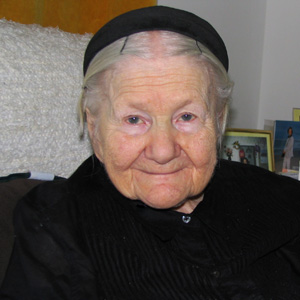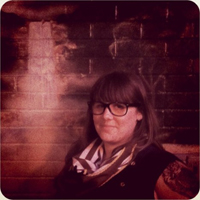 The following essay is the fourth in this six-part column for CR. Developed during Polish Movie Nite, a series of film screenings held at The Polish Club in San Francisco, these texts aim to introduce a wide variety of subjects that might be classified “Polish” to an interested American audience.
The following essay is the fourth in this six-part column for CR. Developed during Polish Movie Nite, a series of film screenings held at The Polish Club in San Francisco, these texts aim to introduce a wide variety of subjects that might be classified “Polish” to an interested American audience.
A documentary by Mary Skinner, “Irena Sendler: In The Name Of Their Mothers” (2010) tells the story of Żegota, a secret network of Polish women who rescued thousands of Jewish children from the Warsaw ghetto during the Second World War. The following essay by curator Susannah Magers explores the poignant issues of memory and identity raised by the film.
– Joanna Szupinska
As a curator, educator, and student of history, the moment of World War II and the Holocaust hold particular significance in my historical memory. Similar to many American schoolchildren, my first introduction to the subject was in a social studies class as a seventh grader at a public school in New Hampshire. We learned about the timeline of the war, read “Night and Day” by Elie Wiesel, and a classmate and I gave a presentation about Auschwitz. The year’s diversity and tolerance-themed curriculum also included readings and discussion of apartheid in South Africa.
I remember that despite the widespread support for this progressive middle school curriculum, there were parents who worried that exposure to this ugly portion of history was inappropriate. This reaction, to protect and shield us from history, puzzled me then as much as it does now. Later, as an undergraduate history major at UC Santa Cruz, I read Primo Levi and Imre Kertesz, saw films such as Night and Fog, Shoah, and The Shop on Main Street, and discovered the meticulous and obsessive architecture of the Holocaust and Nazi ideology. In The Name Of Their Mothers is a story of how this architecture was undermined and resisted. The story of the silencing of Irena Sendler’s experience, as is recounted in the film, is a reminder of how fortunate I was to have been exposed to this history – one whose living testaments so often go unheard.
The Landscape of Warsaw During WWII
As a social worker in Warsaw when World War II broke out in 1939, Sendler was assigned as a public health provider. This involved treating the children she found wandering on the streets of the city, but it’s important to note that Nazi policy allowed Sendler to treat only Catholic Poles, not Jews. In 1940, a wall was erected, enclosing a portion of Warsaw’s center – a mere two square miles – into a ghetto for the 400,000 Jews that lived in the city. Deeply troubled after learning what transpired behind these walls, Sendler began to organize a system for getting the ghetto’s children out. Her project involved the participation of many, with no guarantee of survival, and risk of death if caught. Despite this, Sendler and her coworkers, mostly women, smuggled these children out in whatever ways they could, tucking them in garbage, toolboxes, suitcases, and bundles of newspaper, or walking them out through city sewers.
The complexity of the navigation of the warring Warsaw landscape is staggering. This was a world where nothing was sacred, remotely safe, or known, and where the fear of being stopped, searched, and interrogated loomed always. That a toddler would be ordered to prove that she was not ‘them’ – through the recitation of a prayer to a religion that wasn’t hers, in a language that might have not been hers either – is one of the most haunting visuals invoked by the film. The degree to which everyone involved had to participate in a constant process of cloaking and concealing, day after day, for the duration of the war, is striking. Escaping the ghetto successfully was only the first step; the children were taken to a safe house before awaiting yet another transfer to the relative safety of a convent or orphanage in rural Poland.
Hidden Children: Double Identity and Forced Forgetting
As I listen to the various accounts as the film progresses, from the hidden children that now enjoy older age, I begin to think about the repercussions of being saved. What exactly is the price? The choice of the word “hidden” to describe the children saved by Sendler and Żegota, is a decidedly appropriate one; everything about their lives was hidden, and what’s more, forcibly forgotten, un-learned, and then re-taught to them, sometimes in the middle of the night. Magda Rucinek recalls waking children to recite Catholic prayers, preparing them for the chance that it would not be her the next time, but the Gestapo.
This double identity is confusing and frightening, as expected, for a child. Faced with the challenge to grasp why you have been taken from your family, coupled with strangers instructing you as to your every move, all with an imperative secrecy, is difficult to comprehend. This adaptation included a new Polish name, language, appearance, and religious system: “you are not Rachel, but Roma; not Isaac, but Jacek.” Boys were put in dresses to confound any attempt to discover their Jewishness from the evidence of their anatomy. Sister Maria Ena, a nun at a Polish convent, tells the story of a young girl Jasia, whose facial features were contained by wrapping her face in bandages. Hidden child Michal Głowiński remembers the forced forgetting of his vocabulary, having to stop himself from using certain words that would betray his background. This crisis of double identification and double loss begs the following questions: what happens when you are a witness to the destruction and disappearance of your own history? How do you contend with the knowledge that you may be the only link to it?
 Irena Sendler’s Legacy
Irena Sendler’s Legacy
Sendler’s story, and the combined efforts of Żegota, have been memorialized in many ways. Life in a Jar, a 1999 high school play in Uniontown, Kansas was the first public recognition for Sendler’s story. The play was put on by four female high school students, who discovered Sendler during research for one of their history classes. Upon discovering Sendler was alive, they were urged by their teacher to visit her in Poland. The play has been performed over 250 times, and is now on DVD. These four students are credited with unearthing Irena Sendler’s story.
Sendler and her network have also been represented in a made-for-television movie called The Courageous Heart of Irena Sendler, with Anna Paquin as Sendler, adapted from the 2005 biography “Mother of the Children of the Holocaust: The Irena Sendler Story,” by Anna Mieszkowska. In 2007, Sendler was nominated for the Noble Peace Prize. (Al Gore took the award for his research into global climate change.) Sendler apparently didn’t meet the Nobel criteria that humanitarian activities must have been done in the past two years prior to nomination. The stories of Żegota and the Polish resistance had been silenced for decades, and have only begun to be told internationally in the last two decades. I am struck by a quote, from the memory of William Donat, regarding a harrowing raid by Polish blackmailers who found the then five-year old Donat in hiding at his aunt’s house. His aunt said, “When this is over, the decent Polish people will remember who sided with our enemies, the Germans.” This appeal to their conscience (and a bribe) was successful then, but proves an empty threat when weighed against how history has negated Sendler and her Polish resistance accomplices. Far from being heralded, they were punished for their bravery and selfless acts by the Communists in Poland when they came to power after the war: a double silence of their efforts.
I want to also address the word and notion of miracle, as if some divine intervention could be attributed to Sendler’s actions. It is invoked often in the film, but it is important to note that the rescue of 2,500 children from the Final Solution was not a miracle. It was the result of persistent courage and compassion, and is very human – a different humanity that sprang to action in the face of the insanity of Nazism. There were real people who took real risks and endured real pain. In The Name Of Their Mothers is a story of those individuals who decided to act against fear for their own lives by going against the Nazi oppressors and their calculated genocide of the Jewish people. It is a reminder that the human spirit can prevail despite the circumstances.
In closing, there were Oskar Schindlers and Irena Sendlers, and their stories are never more relevant than now. In an interview in 2007 with ABC News, Sendler voiced her own frustration: “After the Second World War it seemed that humanity understood something, and that nothing like that would happen again. Humanity has understood nothing. Religious, tribal, national wars continue. The world continues to be in a sea of blood.” She went on to say, “the world can be better if there’s love, tolerance, and humility. It is simple. If you see someone drowning, give them your hand.” The question now is not to ask how this could have happened, but how we will prevent it from happening again. CR
Imagery courtesy of 2B Productions
- Hidden Jewish children at a Polish convent, 1943
- Irena Sendler in Warsaw at age 95, 2005
 Susannah Magers is a curator and writer. She earned her MA in Curatorial Practice at the California College of the Arts, San Francisco, and a dual BA at UC Santa Cruz, where she studied Fine Art with an emphasis on Photography, and European History, with an emphasis on the Second World War.
Susannah Magers is a curator and writer. She earned her MA in Curatorial Practice at the California College of the Arts, San Francisco, and a dual BA at UC Santa Cruz, where she studied Fine Art with an emphasis on Photography, and European History, with an emphasis on the Second World War.




Pingback: Krystyna Wituska: Her Life and Literary Afterlife